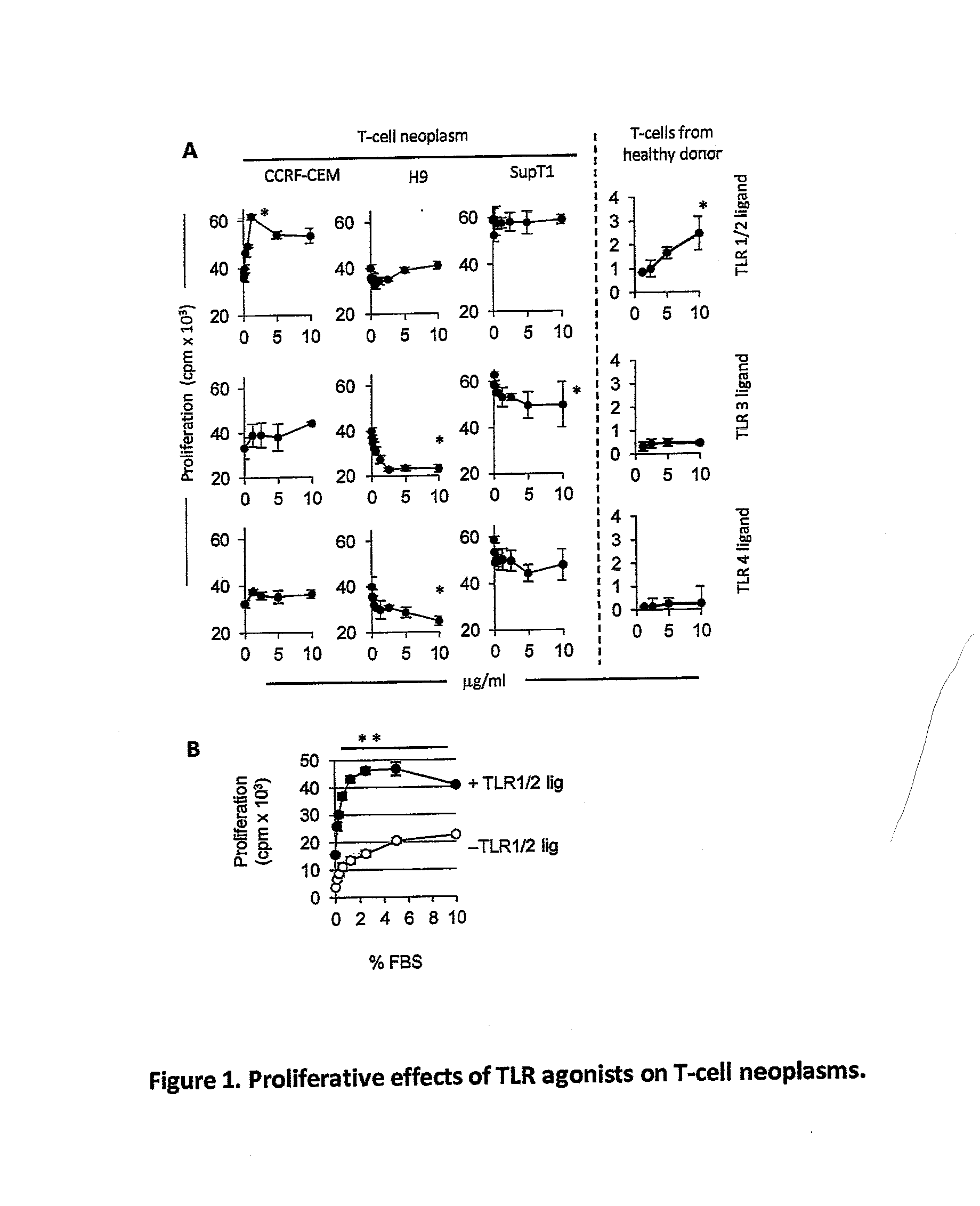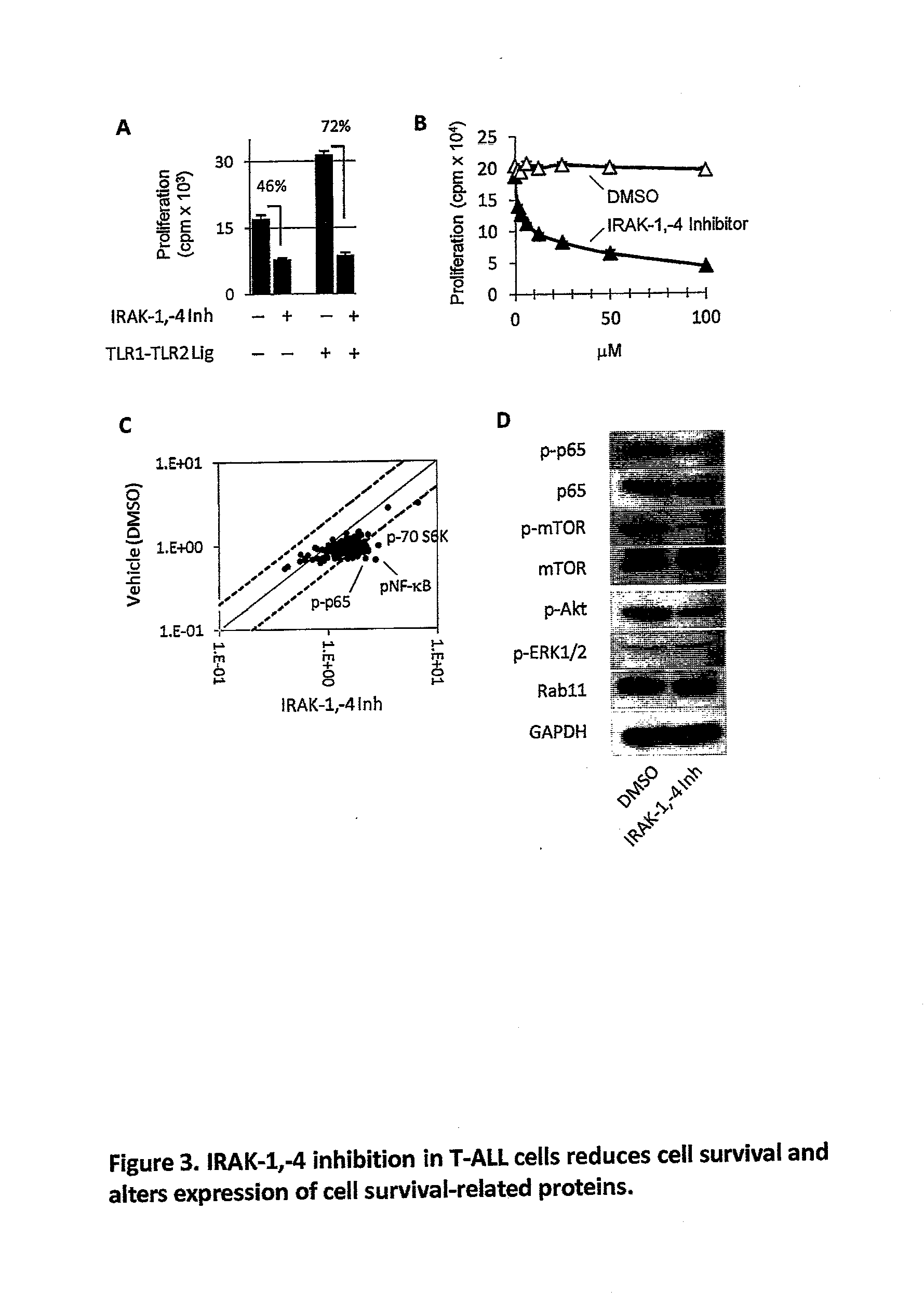Total and Phosphorylated IL-1 Receptor-Associated Kinase-1 and IL-1 Receptor-Associated Kinase-4 as a Biomarker for Cancer Progression and Chemotherapy Resistance
a technology of il-1 receptor and il-1 receptor, which is applied in the field of total and phosphorylated il1 receptor-associated kinase1 and il1 receptor-associated kinase4 as a biomarker for cancer progression and chemotherapy resistance, can solve the problems of poor prognosis for relapsing patients, high risk of t-all patients, and increased risk of early recurrence and cns relapse, so as
- Summary
- Abstract
- Description
- Claims
- Application Information
AI Technical Summary
Benefits of technology
Problems solved by technology
Method used
Image
Examples
example 1
Materials and Methods for T-ALL Cell Lines
[0127]CCRF-CEM, CEM / C1, CEM / C2, CEM-C7, Jurkat, Loucy, Molt-4, HSB-2, SUP-T1, Hut 78, HH, Hut 102, MO, and H9 T-leukemia and T-lymphoma cell lines were purchased from the American Type Culture Collection (Manassas, Va., USA). All of the cell lines were initially expanded and cryopreserved within one month of receipt. Cells were typically used for 6 months at which time a fresh vial of cryopreserved cells was used. Total T cells from healthy donors were isolated via negative selection followed by positive selection using a CD3+ selection kit (Invitrogen, Carlsbad, Calif.). T cells were isolated from patients with T-ALL bone marrow or peripheral blood samples containing more than 70% leukemia cells using a CD2+ isolation kit (STEMCELL Technologies, Vancouver, Canada). All tissues were collected under institutional IRB-approved protocols and all participants gave written informed assent / consent. For in vitro experiments, T-ALL cells were cultur...
example 2
T-Cell Leukemia / Lymphoma Proliferative Response to TLR Agonists
[0135]Recent studies demonstrate that TLR engagement on primary T cells influences proliferation and survival (4-12). However, neither the TLR expression profile nor the physiological importance of TLR signals in human T-cell neoplasms has been fully characterized. The proliferative effects of TLR1-TLR9 agonists were examined in nine human T-cell leukemia and five T-lymphoma lines. Malignant T-cell lines responded differently to specific TLR ligands. For example, whereas the pre-T-ALL cell line CCRF-CEM proliferated in response to Pam3CysK4 (TLR1-2 agonist; 1.2 μg / ml), this ligand had no effect on proliferation of H9 T-lymphoma or SupT1 T-lymphoblastic leukemia at the different concentrations tested (FIG. 1A). In contrast, the TLR3 ligand poly I:C significantly reduced the proliferation of H9 cells while displaying a moderate anti-proliferative effect on SuptT1 cells at concentrations above 0.6 μg / ml. However, TLR3 agoni...
example 3
TLR Expression Profiles in Different Malignant T-Cell Subsets
[0138]Expression of TLR1-TLR9 on T-cell leukemia and lymphoma lines were assessed by western blot. With the exception of Hut 78, all T-cell neoplasms expressed variable levels of TLR1 (FIG. 2, FIG. 16B). Similarly, most cell lines expressed detectable but variable levels of TLR2. TLR3 was absent or weakly expressed in T-lymphoma lines but present on lymphoblastic leukemia cell lines. TLR4 expression was most prominent on Hut 102 T-lymphoma cells while Jurkat, Molt4, Hut 78, MO, and H9 expressed moderate levels. TLRS was weakly expressed by all cell lines except Hut 78 and HH, which did not express TLRS. TLR6 was most highly expressed on HSB2, Hut 78, and H9 and weakly expressed by the other cell lines. All cell lines except Hut 102 expressed variable levels of TLR7. The pre-T-ALL lines CCRF-CEM, CEM / C1, CEM / C2, and CEM / C7 expressed high levels of TLR9, whereas Molt-4 and H9 showed moderate levels of TLR9.
[0139]Expression l...
PUM
| Property | Measurement | Unit |
|---|---|---|
| Dimensionless property | aaaaa | aaaaa |
| Composition | aaaaa | aaaaa |
| Electrical resistance | aaaaa | aaaaa |
Abstract
Description
Claims
Application Information
 Login to View More
Login to View More - R&D
- Intellectual Property
- Life Sciences
- Materials
- Tech Scout
- Unparalleled Data Quality
- Higher Quality Content
- 60% Fewer Hallucinations
Browse by: Latest US Patents, China's latest patents, Technical Efficacy Thesaurus, Application Domain, Technology Topic, Popular Technical Reports.
© 2025 PatSnap. All rights reserved.Legal|Privacy policy|Modern Slavery Act Transparency Statement|Sitemap|About US| Contact US: help@patsnap.com



